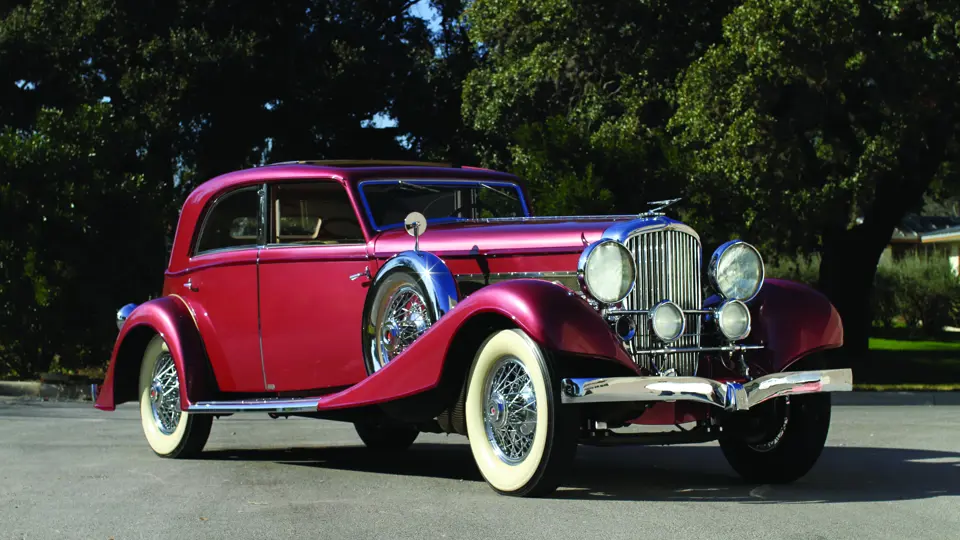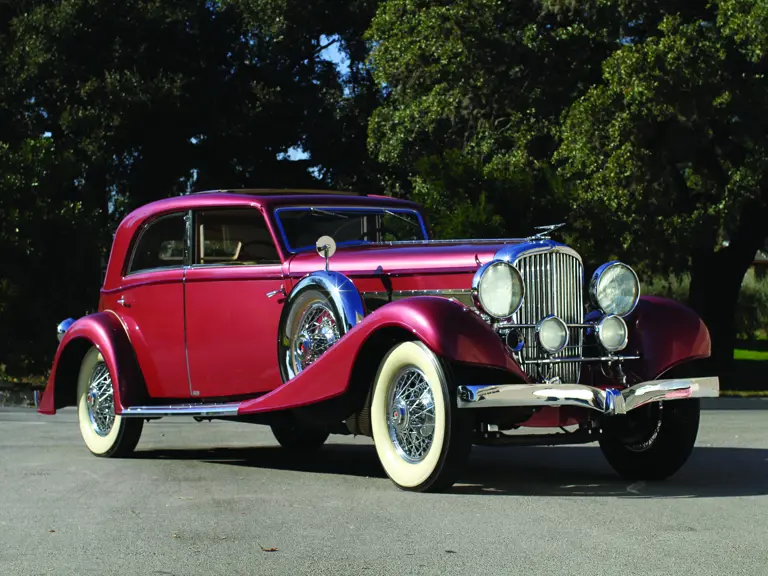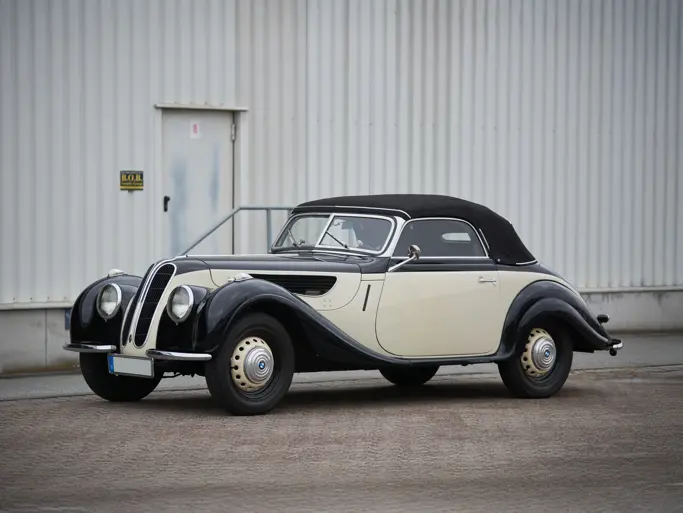
1933 Duesenberg Model J Berline by Franay
{{lr.item.text}}
$715,000 USD | Sold
{{bidding.lot.reserveStatusFormatted}}
- 420-cid, 320-hp DOHC straight eight-cylinder engine
- Three-speed transmission
- One of approximately 480 J's built
- Restored with well-known history
- Rare European coachwork
- 1932 & '32 Paris Salon car
- Original owner; socialite Mabel Boll, "The Queen of Diamonds"
- "The Mabel Boll" diamond is world renowned
- Beautifully restored
- Known ownership history
- Desirable period luxuries & features
- Vacuum-assisted four-wheel hydraulic drum brakes
Glamorous life of travel, high fashion, and social status in the 1920s and ‘30s required a gusher of money. Wealth like that was not drawn from widely held corporations, but often from privately won fortunes generated by hard-driven individuals who often had little or no formal training or background in their fields. Others were from old money, royalty, movie stars or had married into families that allowed all at this social echelon to live a life of extravagance that included the finest automobiles in their coachhouses.
In automobiles, Duesenberg of Indianapolis, Indiana has always meant the epitome of quality. Cars built to special order for the most discriminating owners, embodying all the features and principals which made the name Duesenberg synonymous with the utmost in quality. Largely recognized in period as the world’s finest automobile, the new Duesenberg Model J had at its core a massive and strong 420-cid, 265 horsepower dual overhead camshaft straight eight-cylinder engine. Its entire construction was proportionately strong, thereby Duesenberg could insure its clientele the greatest safety, endurance and absolute dominion. It exceled equally in every other respect of its form.
With double the horsepower of any other motorcar of the era, it equally outclassed all others in smoothness, ease of handling, road steadiness, riding quality, comfort, stamina, longevity and luxury. No other car of this Classic era was thought of as being so easy to handle or so pleasant to drive. No other car had as much horsepower, as smooth performance or as safe control. Queen Marie of Yugoslavia commanded her Lady of Honor to express her entire satisfaction with the “absolute security” of her Duesenberg at high speed, its “grand comfort, remarkable suppleness and supreme elegance.” Parisian perfume manufacturer Virgil Neal reportedly had lavished $41,000 for a sumptuous Hispano-Suiza town car; he wrote from the Riviera expressing his amazement of his J’s performance on an extended journey through the Italian Alps, the Tyrol and the Swiss Alps. He related how, while touring in Europe, he found himself “driving a regular car show,” with people gathering around his Duesenberg when stopped, in numbers the local police needed to be called to clear the streets.
Its speed, not even closely approached by others that had been considered fast, was merely the inevitable byproduct of Duesenberg’s aim to build superfine cars with wholly unmatched performance and extraordinary dependability and durability. Duesenberg proclaimed an unswerving devotion to one ideal…”to produce the best, forgetful of cost, or expediency or any other consideration. A Duesenberg definitely excels every other automobile in the world, in every way.”
When Duesenberg’s Export Manager, Vance C. Hall introduced the J to Europe in conjunction with the various auto exhibitions for 1930 models, he found warm receptions everywhere. The J made its European debut in Paris at the 23rd Annual Salon d’Automobile held at the Grand Palais in October 1929. At the London show, Mr. Hall recalled over 15,000 pieces of literature being handed out to the enthusiastic viewing public. After Paris and London, the Duesenberg J was received in Prague, Geneva and Milan at their motorcar exhibits.
Vanity Fair announced in May 1930 that Duesenberg was the winner of Elegance Rallye’s at Cannes and Pau France, in competition with 150 of the period’s world’s costliest cars. These were two of the most important fine car exhibitions in France; in order to merit this distinction, the Duesenberg had to not merely excel all other cars in every respect, but had to do it so definitely by such a large margin as to establish itself in a realm of its own. The Duesenberg did, firmly and with finality. Its status still reigns supreme, nearly nine decades after introduction.
Many have said that the most rare and distinctive of all Duesenbergs are the few, exclusive models that were assembled by the great European coachbuilders; amongst them you will find Letourneur & Marchand, Hibbard & Darrin, Fernandez & Darrin, Saoutchik, Figoni, Graber, Van den Plas and more, including Franay located in Paris.
The mighty Duesenberg J series was an exotic, imposing and elite automobile. It was far superior in concept and execution from even the largest and most powerful European vehicles of the period. This irresistible interest led the few Duesenbergs bodied in Europe to receive the coachbuilders’ most extravagant, beautiful and eloquent designs. This stunning example crafted by Jean-Baptiste Franay is no exception and its amazing appeal is only rivaled by the air of mystery, intrigue and excitement which surrounds its first owner; Mabel Boll and by then known as the Countess Proceri.
Mabel Boll was widely known in her day as the “Queen of Diamonds” for she loved not only to purchase jewels, but to wear them publicly. This press-labeled “Queen” started out selling cigars in Rochester, New York. She became an experienced horse rider and married businessman Robert Scott in 1909. In 1922 she married again to a Colombian coffee magnate, Hernando Rocha, who presented her with more than $1 million in jewels and a 46.57-carat emerald-cut diamond bearing her name. “The Mabel Boll” diamond was purchased by famed jeweler Harry Winston upon her death in 1949. With the Hope Diamond (he donated it to the Smithsonian in November, 1958) as the echelon of his collection; Winston is reported to have owned 31 of the most important diamonds in the world, of which “The Mabel Boll” is also listed. Winston crafted it to his own design at 44.76 carats; the stone is a near colorless, elongated emerald-cut.
It is said the much-married American socialite was often in the news in the 1920s. Boll collected nicknames like she collected jewelry: in 1921 she was hailed by newspapers as "Broadway's most beautiful blonde." When she married the Colombian coffee king in 1922 the press referred to her as the "$250,000-a-day bride." The "Queen of Diamonds" moniker became popular as she often appeared in public wearing much of her jewelry. It was said that the rings she wore on her left hand alone were worth more than $400,000, which would equate to approximately $5 million in today's dollars.
Mabel Boll not only enjoyed well publicized jewels, but a yen for a place in the public news and a good deal of innate courage as well. George Palmer Putnam; publisher, Amelia Earhart’s aviation sponsor and eventual husband, recounted in his memoirs “Soaring Wings” that, in regards to being the first woman to cross the Atlantic Ocean, “She (Amelia) developed the idea she wanted to fly the Atlantic. And so when AE started - and with a good deal more impulse than planning - Miss Boll just up and started too. She actually got as far as Harbor Grace in Newfoundland in her plane, while AE was poised at Trepassey, so it took no great journalistic ingenuity to make it look like a race... Mabel's plan was to have her plane piloted by - Bill Stultz. .. they were old friends.”
The Countess had the intangible spark of life, liberty, talent, determination, independence, personality and style that distinguished many of the bright and adventuresome young ladies of the late Twenties and early Thirties. She had the desire to collect another nickname, this time “The Queen of the Air.” Her yearning for this aerial adventure of being the first woman to cross the Atlantic was financed by Columbia Aircraft Corp. Chairman Charles Levine, one of Boll’s liaisons. Earhart would win this press-created battle; Mabel Boll would continue various flying exploits until 1936 when she announced she no longer had her obsession to fly.
In April 1931, Time magazine recorded the marriage of Mabel “Queen of Diamonds” Boll to Count Henri de Porceri, who was born in Poland and became a U.S. citizen. They were married in Paris and traveled extensively. In early 1934, still essentially a new car, the Countess acquired the J- 365 Duesenberg Sunroof Berline by Franay, reportedly putting the car in her own name and not her husbands – perhaps wisely as they were divorced after five years of marriage.
According to Ray Wolffe, the well-respected late Auburn, Cord, Duesenberg historian, this chassis was delivered new to France and it appears to have been first fitted with town car coachwork by the French firm of Kellner. For reasons unknown, the car was not sold in this configuration and the body is thought to have later been fitted and sold as J-516, also on a long wheelbase chassis. In August 1931, the J was adorned with new “sports sedan” coachwork by Franay, with a rare for Duesenberg sliding sunroof, divider window and fully-skirted rear fenders. In this new configuration the car was exhibited at the October 1931 Paris Salon with two-tone paintwork. A year later the car was again back at the Paris Salon, but this time it was painted in just one color.
In January or February of 1934 the car was sold to the Countess Proceri. Very little is known of the car again until the early 1950s when retired schoolteacher, Henri Beaud of Villeneuve, owned the car. In the late 1950s the car was purchased in a partnership between Henri M. Petiet and Serge Pozzoli. Pozzoli is said to be one of the first in France to realize the historical importance of the motorcar. From 1965 until 1971, Paul Badre of Paris was its custodian, at which time Marc Nicolosi brokered the car to Gavin S. Herbert of Newport Beach, California. In 1974 the car changed hands again, selling briefly to Jonnie Bassett before ending up with Ray Egidi of Florida who quickly had the car restored.
A year later the car sold to well-known jeweler Marvin Cohen of Chicago, Illinois, who carried out a major concours-type quality restoration in 1975 with some modifications to enrich the car’s overall appearance. This included enhancing and integrating the sloping roof and body line by taking off the built-in trunk, lengthening the hood, replacing the side louvers with chromed screens plus side exhaust, special cabinetry on the back of the front seat and painting the body in its current magenta shade. Mr. Cohen sold the vehicle at auction to Patrick Ryan in 1988, who was making one of his first forays into buying Classics. One of the first people to congratulate Mr. Ryan on his purchase was the late Lorin Tyron, one of the famous driving forces behind the Pebble Beach Concours d’Elegance. Only two have owned this impressive Duesenberg J since.
The “Queen of Diamonds” Duesenberg is a stunning example of 1930s beauty and refinement; it is believed to be one of only two Duesenbergs originally built with a sunroof. Other exciting qualities are seen with its hinged windshield, divider window, chromed-cover dual sidemounts, luggage rack, skirted fenders, driving lights, chromed wire wheels, ornate rear woodwork with bar, crystal and instrumentation, plush leather interior, engine-turned dash fascia and desirable sweep-hand speedometer and tachometer amongst the standard and very complete Duesenberg instrument set.
Mabel Boll's Duesenberg is seen and recognized in the majority of books on the marque and will be welcomed by most clubs and events on the calendar for this era of motorcar. Period photos reveal the car during its early years abroad and relate its well-known history as it remains with most features from this wonderful record of presentation.
The Duesenberg J was a conception of motoring excellence that was apart from the field in its appeal to the owner as driver. The last chapter of the Salon era was chronologically ushered in by the J, by reason of its new level of standards for motorcar finality – coachbuilders and Duesenberg achieved undisputed new heights in the perfection of design and elements of motoring distinction. New levels of luxury, new vistas of prestige, performance, comfort and size were attained – the examples, such as this Duesenberg, stand as a model of uncompromised beauty for comparison in any age.


 | Auburn, Indiana
| Auburn, Indiana


